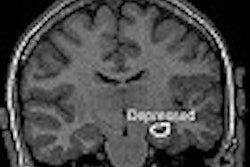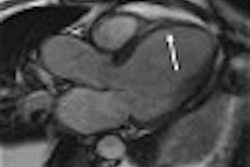Patients with migraines are at increased risk of developing lesions in certain areas of the brain, researchers report in the Journal of the American Medical Association.
"These results, for the first time, unequivocally demonstrate that migraine patients have an increased risk of brain damage," wrote lead investigator Dr. Mark Kruit from the faculty of radiology at Leiden University Medical Center, Leiden, the Netherlands. "The observed association between migraine attack frequency and brain lesions suggests that the observed brain damage is caused by migraine attacks."
The investigators enrolled Dutch adults at two different centers, ages 30-60, 161 of whom had migraine with aura, 134 had migraine without aura, and 140 controls. The patients underwent MR imaging on a 1.5-tesla unit (ACS-NT, Philips Medical Systems, Best, the Netherlands) or a 1-tesla unit (Magnetom Harmony, Siemens Medical Solutions, Erlangen, Germany).
Protocols at the two centers were comparable. Whole-brain images were acquired with 48 contiguous 3-mm axial slices. Pulse sequences included combined proton density (PD) and T2-weighted fast spin-echo and fluid-attenuated inversion recovery (FLAIR). MR images were analyzed for infarcts and for white-matter lesions (WML).
For overall infarct, the researchers found no statistically significant difference between patients with migraine (8.1%) and controls (5%). But they found that in the cerebellar region of the posterior circulation territory, migraineurs exhibited an infarct rate (5.4%) that was seven times higher than controls (0.7%).
The investigators also found that subjects who experienced migraine with aura showed a 13 times greater risk for infarct than controls. Subjects with migraine at one or more episodes per month had a 9.3 times increased risk of infarct. Subjects who experienced migraine with aura, and one attack or more per month, had the highest infarct risk (15.8 times increased risk rate).
Women migraineurs showed twice the risk for deep WMLs compared to female controls. Their risk grew with attack frequency, reaching 2.6 times relative risk for those with one or more monthly migraines. The rate was similar among female subjects with migraine with or without aura. Among men, migraineurs and controls did not differ in the prevalence of deep WMLs.
In an accompanying JAMA editorial, Dr. Richard Lipton and Dr. Jullie Pan, Ph.D., noted: "These data have implications for current concepts of migraine as a disease; migraine should be conceptualized not just as an episodic disorder but as a chronic-episodic and sometimes chronic-progressive disorder" (January 28, 2004, Vol. 291:2, pp. 427-434).
Lipton is a professor of neurology, and Pan an associate professor of neuroscience, at the Albert Einstein College of Medicine in New York City.
This shift in disease conceptualization could alter treatment protocols as well, they added. "If the brain lesions demonstrated by Kruit et al have a significant clinical correlate, preventing the accumulation of brain lesions may become an additional goal of treatment. Emerging treatment strategies to prevent disease progression, including risk-factor modification, preventive therapies, and the early use of acute treatments, are an important focus for future investigation," Lipton and Pan wrote.
In an interview with AuntMinnie.com, Kruit discussed how this new information could affect the way radiologists read for cerebral infarcts.
"Cerebellar infarcts seldom occur in patients without migraine and are a relatively frequent finding in migraine patients; therefore, radiologists should include migraine in their differential diagnosis of cerebellar infarcts," he explained. "The white-matter lesions that we observed in migraine patients are specific and may occur in a large number of other conditions. Migraine could be added to the differential diagnosis of such lesions."
Kruit noted that evidence is presently lacking in favor of MR imaging of migraine patients with a typical clinical picture. Nevertheless, performing neuroimaging in patients with atypical migraine, or recent changes in migraine pattern, should be maintained, he said.
By Bruce SylvesterAuntMinnie.com contributing writer
February 18, 2004
Related Reading
Migraine findings spotlight laser imaging, March 19, 2002
Migraine characterized by higher amplitude B waves in middle cerebral artery, April 11, 2001
PET imaging shows distinct pathogenicity of migraine, April 7, 2001
Copyright © 2004 AuntMinnie.com



















